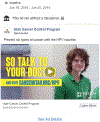Vaccine-related advertising in the Facebook Ad Archive
- PMID: 31732327
- PMCID: PMC6954281
- DOI: 10.1016/j.vaccine.2019.10.066
Vaccine-related advertising in the Facebook Ad Archive
Abstract
Background: In 2018, Facebook introduced Ad Archive as a platform to improve transparency in advertisements related to politics and "issues of national importance." Vaccine-related Facebook advertising is publicly available for the first time. After measles outbreaks in the US brought renewed attention to the possible role of Facebook advertising in the spread of vaccine-related misinformation, Facebook announced steps to limit vaccine-related misinformation. This study serves as a baseline of advertising before new policies went into effect.
Methods: Using the keyword 'vaccine', we searched Ad Archive on December 13, 2018 and again on February 22, 2019. We exported data for 505 advertisements. A team of annotators sorted advertisements by content: pro-vaccine, anti-vaccine, not relevant. We also conducted a thematic analysis of major advertising themes. We ran Mann-Whitney U tests to compare ad performance metrics.
Results: 309 advertisements were included in analysis with 163 (53%) pro-vaccine advertisements and 145 (47%) anti-vaccine advertisements. Despite a similar number of advertisements, the median number of ads per buyer was significantly higher for anti-vaccine ads. First time buyers are less likely to complete disclosure information and risk ad removal. Thematically, anti-vaccine advertising messages are relatively uniform and emphasize vaccine harms (55%). In contrast, pro-vaccine advertisements come from a diverse set of buyers (83 unique) with varied goals including promoting vaccination (49%), vaccine related philanthropy (15%), and vaccine related policy (14%).
Conclusions: A small set of anti-vaccine advertisement buyers have leveraged Facebook advertisements to reach targeted audiences. By deeming all vaccine-related content an issue of "national importance," Facebook has further the politicized vaccines. The implementation of a blanket disclosure policy also limits which ads can successfully run on Facebook. Improving transparency and limiting misinformation should not be separate goals. Public health communication efforts should consider the potential impact on Facebook users' vaccine attitudes and behaviors.
Keywords: Advertising; Facebook; Misinformation; Social Media; Transparency; Vaccine Hesitancy.
Copyright © 2019 Elsevier Ltd. All rights reserved.
Conflict of interest statement
Declaration of interests
The authors declare that they have no known competing financial interests or personal relationships that could have appeared to influence the work reported in this paper.
Figures





Comment in
-
Announcing the Lancet Commission on Vaccine Refusal, Acceptance, and Demand in the USA.Lancet. 2021 Mar 27;397(10280):1165-1167. doi: 10.1016/S0140-6736(21)00372-X. Epub 2021 Feb 24. Lancet. 2021. PMID: 33639088 No abstract available.
References
-
- Facebook Newsroom. https://newsroom.fb.com/company-info/. Published 2019. Accessed May 16, 2019.
-
- Matsa KE, Shearer E. News Use Across Social Media Platforms 2018. Pew Research Center; 2018; https://www.journalism.org/2018/09/10/news-use-across-social-media-platf.... Accessed March 14, 2019.
-
- Shearer E Social Media Outpaces Print Newspapers in the U.S. as a news Source. Pew Research Center; https://www.pewresearch.org/fact-tank/2018/12/10/social-media-outpaces-p.... Published December 10, 2018. Accessed May 16, 2019.
-
- Metz C How Facebook’s Ad System Works. New York Times. October 12, 2017:3.
-
- Warner KE. Tobacco industry response to public health concern: a content analysis of cigarette ads. Health Educ Q. 1985;12(1):115–127. - PubMed
Publication types
MeSH terms
Substances
Grants and funding
LinkOut - more resources
Full Text Sources
Miscellaneous

